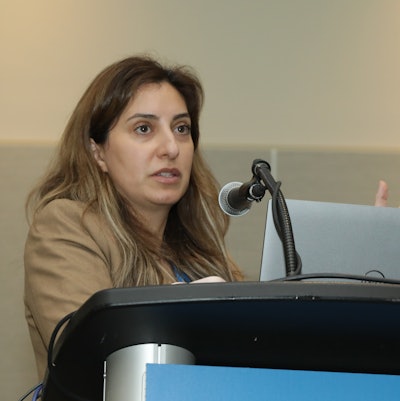Burdened by prior authorizations?
Technology, artificial intelligence, and other resources are vital to streamlining the process.

New treatments are changing the face of dermatology every day, but there is one roadblock that often gets in the way of a dermatologists’ ability to get those treatments to their patients: prior authorization (PA).
Justin Ko, MD, MBA, FAAD, co-director of Monday’s session, F091 – Navigating Prior Authorization in Dermatology: Challenges, Innovations, and Solutions, described the burden of prior authorization as “the perfect storm.”
“In dermatology, we have these incredibly innovative treatments that can be life-changing for patients, though they are expensive, and the system for getting them approved is stuck in the dark ages,” he said. “It’s a constant battle against paperwork and red tape where patients, dermatologists, and our clinic staff are trapped in the middle.”
Session co-director Milad Eshaq, MD, FAAD, pointed to several reasons for the increasing responsibility of prior authorizations on dermatology, including the advent of newer, more expensive dermatologic therapeutics, constantly changing formularies making consistency difficult, and the introduction of PA requirements for medications that previously did not require them. And the burden doesn’t stop with the dermatologists themselves.
“Valuable physician staff time that could be better spent on direct patient care is instead spent on bureaucratic hurdles to get medications approved for patients,” said Dr. Eshaq, who is clincal associate professor of dermatology at the University of Michigan in Ann Arbor. “Most importantly, our patients are the ones who suffer immensely from delays and disruptions in care.”
Technical advances
Dr. Ko, who is a clinical professor and chief of medical dermatology for Stanford Health Care in California, said he believes technology is the key to unlocking the path forward for prior authorization.
“Imagine tools that can support a physician by predicting approvals, automatically filling out forms, and even guiding us toward the right medications,” he said. “That’s the future we need and frankly our patients and practices deserve.”
One technology that could be a game changer in this area is ambient intelligence, which uses artificial intelligence (AI) in devices that are able to detect the presence of humans and adapt and respond accordingly.
“Think voice assistants and AI agents that go beyond populating notes to capture patient data and automatically populate prior authorization requests, generating summaries for patients,” Dr. Ko said. “It would free up so much time and help augment the quality and experience of patient care we could provide.”
Ethical pros and cons
But even Dr. Ko admitted that this technology is in the very early stages. In the meantime, dermatologists still have to deal with the realities of prior authorizations, including the ethical implications of using AI.
Jane Grant-Kels, MD, FAAD, said there are a number of concerns when it comes to using AI for prior authorizations, not the least of which is the potential for errors.
 Jane Grant-Kels, MD, FAAD
Jane Grant-Kels, MD, FAAD
Dr. Grant-Kels, who is professor of dermatology, pathology, and pediatrics, and vice chair of the department of dermatology at the University of Connecticut in Farmington, said there are other considerations as well, including the potential for bias and outdated information in AI systems. Whether or not the PA is done properly for each patient, the need for patient consent could lead to some patients opting out of the new AI tool, depriving it of required data.
She said that AI systems will be adopted by dermatologic practices, but urged caution to avoid some of the ethical pitfalls involved.
“When we do add AI to our practice, we must remember to get patient buy-in by getting their informed consent to use these systems in their care,” Dr. Grant-Kels said. “AI accuracy and privacy issues also need to be addressed and must be reliable and secure to prevent further delays in care and worsen health disparities.”
Health care vs. insurance
Health care professionals aren’t the only ones using technology to manage the PA process. Faranak Kamangar, MD, FAAD, said that insurance companies are leveraging technology to their advantage as well.
 Faranak Kamangar, MD, FAAD
Faranak Kamangar, MD, FAAD
Artificial intelligence is playing a key role on the dermatologic side of that ongoing battle, with several advances taking center stage.
“Large language models like Derm GPT can analyze clinical notes and images to strengthen authorization requests,” she said. “Predictive analytics can identify patterns in approval and denial decisions to optimize submissions. AI-powered clinical decision support tools help ensure that submissions meet payer-specific criteria, and automated systems can generate comprehensive prior authorization narratives based on patient records.”
Streamlining
Beyond high-tech tools, there are some additional tips and tricks that can help you streamline the PA process to help ensure approvals. Angela Lamb, MD, FAAD, associate professor of dermatology at Icahn School of Medicine at Mount Sinai in New York City, and vice chair of clinical operations and strategy for the department of dermatology, said one example involves creating a biologics referral that is picked up directly by the clinical pharmacist, nurse practitioners, and physician assistants.
“We write the order and it routes on the back end to the pharmacy team,” she said. “Before we changed that, we actually placed a referral in the system which led to delays and lower chance of approval.”
Another suggestion Dr. Lamb offered was to streamline the prior authorization process to help make your practice more efficient and give you the freedom to write the best prescriptions for your patients.
“We’ve done things like creating fields that auto populate in the medication order or chart when you write a prescription that include medications that have been tried and failed,” she said. “This can help you get ahead of the documentation burden.”
Resources for dermatologists
As the prior authorization process continues to be increasingly complex and time-consuming, Ryan Hick, MD, FAAD, a dermatopathologist and dermatologist based in Dallas, said insurance companies are constantly looking for new areas in which to institute PA policies.
“Payers have attempted to implement PA for some surgical procedures, including repairs for Mohs surgery such as adjacent tissue transfer,” he said. “In some instances, diagnostic testing has been a target of PA implementation, such as a recent attempt to require PA for immunohistochemistry for dermatopathology. Payer policies often vary widely, creating inconsistency and uncertainty for physicians and patients alike. This fragmented system not only delays care but also increases administrative burdens on practices.”
But there is hope. Dr. Hick said the Academy has prioritized reducing the burden of PAs as part of its advocacy agenda.
“The Academy engages frequently with payers to advocate for greater transparency and the elimination of excessively burdensome requirements,” he said. “The Academy’s efforts were integral to reversing or preventing the implementation of policies that would have seen surgical procedures and dermatopathology testing impacted with onerous PA requirements.”
Dr. Hick said the Academy also provides plenty of resources for dermatologists to navigate the PA process, including templates, guides, and educational webinars. You can find these within the Academy’s online Practice Management Center.











